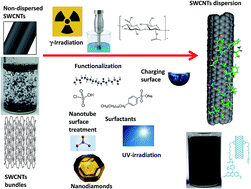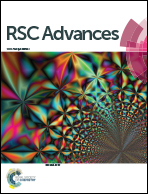The dispersion, solubilization and stabilization in “solution” of single-walled carbon nanotubes
Abstract
A series of contemporary techniques, used for SWCNTs solubilization, from physical (classic ultrasound (stable and inertial cavitation types of ultrasonic treatment are emphasized), radiation treatment or UV and visible light influence) to chemical and biological, applying inorganic (nanodiamonds, iodine, metallic sodium in liquid ammonia, peroxides, and mineral acids) and organic (acids, salts, polymers, dyes, natural products and biomolecules) compounds, have been reviewed. van der Waals interactions, π–π stacking interactions between aromatic rings in organic compounds and nanotubes, and hydrophobic interactions are major factors that are responsible for CNTs dispersion. Despite the similarity of dispersion methods for all types of nanotubes, several differences are observed for SWCNTs, DWCNTs and MWCNTs. Among other aspects for SWCNTs dispersion, a variety of functionalization routes are discussed, including double-covalent functionalization of nanotubes, as well as thermodynamic and kinetic approaches towards the stability of the formed CNTs dispersions and the prevention of SWCNTs reaggregation.


 Please wait while we load your content...
Please wait while we load your content...